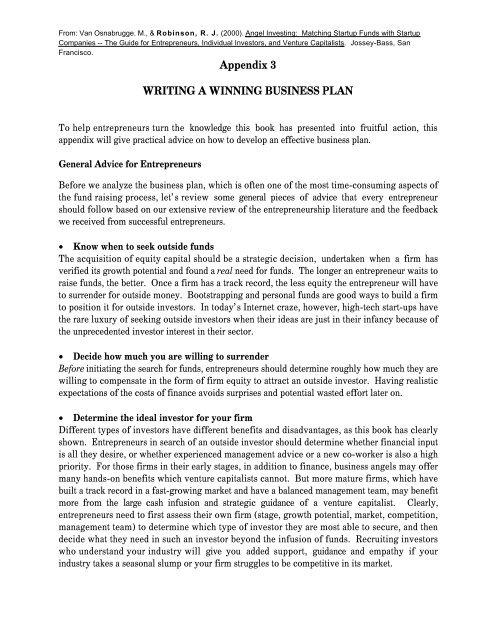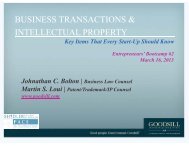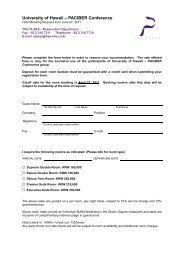Appendix 3 WRITING A WINNING BUSINESS PLAN
Appendix 3 WRITING A WINNING BUSINESS PLAN
Appendix 3 WRITING A WINNING BUSINESS PLAN
Create successful ePaper yourself
Turn your PDF publications into a flip-book with our unique Google optimized e-Paper software.
From: Van Osnabrugge. M., & Robinson, R. J. (2000). Angel Investing: Matching Startup Funds with StartupCompanies -- The Guide for Entrepreneurs, Individual Investors, and Venture Capitalists . Jossey-Bass, SanFrancisco.<strong>Appendix</strong> 3<strong>WRITING</strong> A <strong>WINNING</strong> <strong>BUSINESS</strong> <strong>PLAN</strong>To help entrepreneurs turn the knowledge this book has presented into fruitful action, thisappendix will give practical advice on how to develop an effective business plan.General Advice for EntrepreneursBefore we analyze the business plan, which is often one of the most time-consuming aspects ofthe fund raising process, let’s review some general pieces of advice that every entrepreneurshould follow based on our extensive review of the entrepreneurship literature and the feedbackwe received from successful entrepreneurs.• Know when to seek outside fundsThe acquisition of equity capital should be a strategic decision, undertaken when a firm hasverified its growth potential and found a real need for funds. The longer an entrepreneur waits toraise funds, the better. Once a firm has a track record, the less equity the entrepreneur will haveto surrender for outside money. Bootstrapping and personal funds are good ways to build a firmto position it for outside investors. In today’s Internet craze, however, high-tech start-ups havethe rare luxury of seeking outside investors when their ideas are just in their infancy because ofthe unprecedented investor interest in their sector.• Decide how much you are willing to surrenderBefore initiating the search for funds, entrepreneurs should determine roughly how much they arewilling to compensate in the form of firm equity to attract an outside investor. Having realisticexpectations of the costs of finance avoids surprises and potential wasted effort later on.• Determine the ideal investor for your firmDifferent types of investors have different benefits and disadvantages, as this book has clearlyshown. Entrepreneurs in search of an outside investor should determine whether financial inputis all they desire, or whether experienced management advice or a new co-worker is also a highpriority. For those firms in their early stages, in addition to finance, business angels may offermany hands-on benefits which venture capitalists cannot. But more mature firms, which havebuilt a track record in a fast-growing market and have a balanced management team, may benefitmore from the large cash infusion and strategic guidance of a venture capitalist. Clearly,entrepreneurs need to first assess their own firm (stage, growth potential, market, competition,management team) to determine which type of investor they are most able to secure, and thendecide what they need in such an investor beyond the infusion of funds. Recruiting investorswho understand your industry will give you added support, guidance and empathy if yourindustry takes a seasonal slump or your firm struggles to be competitive in its market.
2Angel Investors• Use your network contactsTo find potential investors, particularly business angels, entrepreneurs must exploit theirbusiness and personal networks to the fullest, as detailed in Chapter 5. With many potentialangels in your geographic area, ‘getting the word out’ is often the best way to find an interestedinvestor. Alternatively, formal matching services can be approached, although they remain at thistime a factor in only a small minority of funding matches. To lure venture capitalists, aprofessional referral is mandatory to gain attention.• Refine your sales pitchDifferent investors are motivated by different things, as we thoroughly discussed throughout thisbook, particularly Chapter 7. Before appealing to the investor type of your choice, know whatin general motivates them most and then tailor your business plan and sales pitch accordingly. Ifyou are fortunate to already have a specific investor in mind, be it an angel of a venture capitalist,find out what their interests are, other ventures they have funded recently, and their primarycriteria and tailor your plan to emphasize these features. Angels often seek excitement and theopportunity to use their own creativity and skills – make sure that your investment opportunityembodies these requirements. Should this particular approach not work for the investor you hadin mind, find another investor– there are plenty of fish in the sea!• Emphasize the uniqueness of your firmNo investor wants to invest their hard-earned dollars into a firm lacking some unique aspectwhich will set it apart from the competition and have the edge that may potentially bring inmillions in revenue. Entrepreneurs should communicate their unique vision for the firm and go topains to clarify its competitive position. A unique edge of some sort is of vital importance.• Emphasize the ‘people aspects’ of your firmInvestors tend to invest more in people than in ideas. A stellar entrepreneur with a lacklusteridea, though not ideal, will have the smarts and experience to change things around to attainsuccess. For angel investors, especially, who often want to work with the entrepreneur, havingconfidence in the entrepreneur is one of the most important characteristics to attract investment.If the people do not have (and can show) a high degree of integrity, motivation and experience,investors will usually pass on the deal.• Know your limitationsIf attempts to attract an outside investor result in an entrepreneur modifying his/her businessplan and venture’s outlook beyond what he/she is comfortable with, the entrepreneur has todecide whether acquiring an outside investor is really worth it, and whether the right type ofinvestors have been focussed on thus far. If an entrepreneur is not entirely happy with what isbeing presented to potential investors, it may certainly be a cause for aggravation at a later stage,after the funds have been secured.• Borrow added credibility
Writing a Winning Business Plan 3Start-up firms and their young entrepreneurs often lack credibility. Though this is an inherentpart of the situation, it can be partly overcome by securing support and backing from moreexperienced and credible outside individuals. First, an entrepreneur may establish a board ofdirectors and fill it with a number of talented and experienced outsiders who can lend their adviceand reputations within the community to the young unproven venture. Second, a board oftechnical advisors may be established, especially for those more technical of firms, to lend addedinsight and credibility. Third, entrepreneurs should create professional advisory relationshipswith respected legal and accounting firms. Forwarding financial statements which have beenverified by a respected ‘Big Six’ accounting firm can certainly lend added credibility and comfortto investors and others. If you negotiate hard, the fees for such an accounting firm may not bemuch higher than for a no-name firm (Welles, 1994). Fourth, any public relations a small firm canget is an added bonus. Though getting featured in a national publication, such as Forbes, may beunlikely, news coverage in trade magazines and the local press can certainly help to expose thebusiness and possibly attract potential investors, or at least give the firm added credibility to lureinvestors. Fifth, if a firm already has outside equity investors, this can improve the odds ofgaining a second round of funds from angels, venture capitalists, and even banks. Already havingsome sort of outside backing adds credibility to the venture – ‘if others have seen fit to invest inthe firm, then my hunch may be right’.• Follow a rifle shot approach (leave the shotgun at home)When selecting angel investors to approach, select only a few (who may be potentiallyinterested) to approach. Tailoring your sales pitch to just a few (in whom you are interested aswell) is a more surefire road to funding success, than using a shotgun approach to reach manyinvestors at once. Quality over quantity rules in the search for equity funds. Additionally, if ashotgun attempt at seeking finance is not received favorably by angels in your area, it will bedifficult to go back to some of them later with a more refined and tailored second attempt.Similarly, when approaching venture capitalists, make sure that you use a referral source for eachinvestment firm considered, and tailor your approach to their investment requirements andmotivations. This is particularly important in the highly-inbred venture capital communitybecause one rejection of a business plan usually reduces the chances that other venture capitalistswill find it attractive.• Target lead investorsIncreasingly, angels are investing in groups to allow more diversification of risk and skills and toafford larger investment opportunities otherwise outside of their grasp. In every such angelsyndicate, there is at least one prominent investor who the others respect and follow.Entrepreneurs must try to target these individuals and gain their approval. Similarly, in venturecapital firms, where investment decisions are made in committees, targeting a particular partnerwho is seen as more sympathetic may allow the entrepreneur to gain an internal champion andbuild momentum (Wasserman, 1999). Also, there are often patterns of deference betweendifferent venture capital firms, where support by one firm can increase the support from others.• Get your foot in the door
4Angel InvestorsMost investment opportunities seen by business angels and venture capitalists are rejectedbefore they even meet the entrepreneur. If an entrepreneur can gain an investor’s attention, thenthe chances of securing funds have already increased dramatically (Riding, 1998).• Check out potential investorsDue diligence is a two-way street. Although entrepreneurs may be hesitant to check outpotential investors for fear of possibly turning away committed funds, it is imperative that theylearn as much as possible about the person to whom they are selling part of their company.Questions every entrepreneur should ask:♦ Are the investor’s motivations in line with what we can realistically offer?♦ Is the investor’s personality compatible with mine?♦ Does the investor share the same goals as me?♦ What other firms has the investor funded in the past?♦ How did these turn out?♦ How active was the investor in those firms?♦ Did the investor make constructive contributions?♦ What do entrepreneurs in those firms (especially those that failed) say about theinvestor?♦ Did the investor stick with these firms in times of trouble?♦ What industries does the investor have experience in?♦ Does the investor understand this firm’s industry sector and can he/she contribute tothis area?♦ How helpful will this investor be in trying to obtain future rounds of financing?♦ Does this investor have the expertise, contacts, and reputation to attract otherpotential investors and build the firm?• Set guidelines with your investorsBefore the investment agreement is drawn up, the entrepreneur and investor must establishguidelines to clarify each person’s role in the venture. The timing and amount of assistance fromthe investor should be agreed upon so that the entrepreneur will know realistically how muchvalue-added assistance to expect, and the investor will feel as if there is a role to play in the firm.Lay it all out on the table before signing on the dotted line.• Set up a formal communication channelOnce the investment has been made, the entrepreneur should establish a formal channel ofcommunication so that contact with investor(s) remains frequent and can lead to valuableassistance from investors (Gruner, 1998).• Be persistentAlthough most investors are very choosy about the deals they fund, it is important to rememberthat there are at least a few committed investors out there for every deal. If negotiations with one
Writing a Winning Business Plan 5investor do not turn out as planned, ask them to kindly refer your investment opportunity toanother potentially-interested investor they know. Angels are often quite happy to do this(Riding, 1998), especially if the opportunity was rejected by them due to lack of sectorknowledge or inability to contribute certain investor skills. Persistence pays - often veryhandsomely in the pursuit of entrepreneurial funds.• Conduct a reality checkIf multiple attempts for funds fail, the investment opportunity may not yet be developed enoughto seek outside funds. Reliance upon other sources may be more appropriate for the time being.If continued attempts fail over time, it is important to recognize that all the money in the worldmay not be able to save a bad idea.Steps to Writing a Persuasive Business PlanCrafting a good business plan is a difficult task, usually involving weeks (if not months) ofendless drafting and re-drafting. But a clear and professional plan is crucial for any business sinceit is the main selling tool in the fund raising process. A good business plan must make animmediate impact if it is to gain interest and follow-up. Potential investors often receive dozens,if not hundreds, of proposals per month. Luckily for first-time entrepreneurs, many books havebeen written on how to put together a good business plan. Many of these sources are, in ouropinion, quite excellent and are certainly very comprehensive. We could make up our own guidehere, but we do not think that we could necessarily do any better. The internet alone offerscountless free (and excellent) business plan guides and any local book store will offer a wideselection too. Take a look through them and decide which style of plan is most to your liking -but remember to keep it short and concise! For starters, we urge entrepreneurs to review some ofthe sources that we liked:♦ How to Write a Great Business Plan, by William Sahlman, in the Harvard BusinessReview, July 1997.♦ Anatomy of a Business Plan, by Linda Pinson and Jerry Jinnett, Fullerton, CA:Martketplace Press, 1999.♦ Business Plans that Work, edited by Susan M. Packsack, Chicago: CCH Inc., 1998.♦ How to Write a Business Plan, Mike McKeever, Berkeley, CA: Nolo Press, 1994.♦ Inc. Magazine’s How to Really Create a Successful Business Plan – Step by Step, byDavid E. Gumpert, Boston: Inc. Publishing.♦ Online Business Planning: how to create a better business plan using the internet,including a complete, up-to-date resource guide, by Robert T. Gorman, FranklinLakes, NJ: Career Press, 1999.♦ The Complete Book of Business Plans: simple steps to writing a powerful businessplan, by Joseph Covello and Brian Hazelgren, Naperville, IL: Sourcebooks Inc., 1994.♦ The Entrepreneurs Guide to Building a Better Business Plan: a step by stepapproach, by Harold McLaughlin, New York: J. Wiley, 1992.
6Angel Investors♦ Total Business Planning: a step-by-step guide with forms, by E. James Burton, NewYork: John Wiley, 1999.Try the internet too:♦ How to Start a Business: Business Plan, Small Business Development Center,available at: http://www.inreach.com/sbdc/book/bizplan.html♦ Creating an Effective Business Plan, American Express’ Small Business Exchange,available at: http://www.americanexpress.com/smallbusiness/♦ The Business Plan: Road to Success: A Tutorial and Self-Paced Activity, SmallBusiness Administration, available at: http://www.sba.gov/starting/indexbusplans.htmlMost of these guides are not written with business angel investors in mind, rather banks andventure capitalists are more common funding targets. In light of this, let's look at some of theaspects of a general business plan that should be emphasized depending upon the type ofinvestor sought.• What business angels particularly look for in a business plan♦ An opportunity to add their own skills and creativity to the venture♦ A trustworthy entrepreneur with a compatible personality♦ A firm in a niche market♦ An early-stage venture whose development they can still shape♦ Healthy financial projections♦ A venture which is within driving distance for the investor• What venture capitalists particularly look for in a business plan♦ An experienced and well-balanced management team with a sound track record♦ A firm with a unique concept/idea that meets an unmet consumer need♦ A target market with almost unlimited growth potential♦ A proven niche product with almost unlimited growth potential♦ Strong competitive position♦ Very healthy, but realistic, financial projections♦ A firm which is usually more developed and looking for expansion funds (not a start-up)♦ Preferably a high-tech firm, but will entertain firms in other sectors♦ Detailed financial statements (preferably with milestone charts)♦ A potential equity stake of around 30% of the company in exchange for funds (thoughthere is much variation)♦ Potential exit routes identifiable at time of investment• What every business plan should haveDifferent business plan manuals stress different content styles and there is no universal best.Depending upon their own preferences and types of businesses, entrepreneurs should select the
Writing a Winning Business Plan 7style which most appeals to them and will allow them to present their opportunity in the bestlight. But, in general, all business plans tend to be variations of the one we feature here, whichhappens to be a simpler variation of a plan featured by the Small Business Development Center –one which we particularly favored:Cover LetterCover SheetTable of ContentsA Sample Table of Contents for a Business PlanExecutive SummaryBusiness conceptNameProduct/serviceMarket and competitionManagement experience/expertiseBusiness goalsSummary of financial needsEarnings projectionsMarket AnalysisTotal market analysisIndustry trendsTarget marketMarket competitionProduct/Service AnalysisProduct line/service descriptionProprietary natureCompetitive threatsMarketing StrategyOverall strategyPricing policySelling, distribution, servicing methodsManagementOfficers, organizational chart and responsibilitiesResumes of key personnelBoard of Directors/Advisors compositionFinancial PlanHistorical analysisBudget projectionsIncome statementBalance sheetsCash flowCapital expendituresExplanation of projectionsKey business ratiosExplanation of financing needs and anticipated use of funds20 General Tips on Business Plan Preparation
8Angel InvestorsEvery business plan is a sales tool and it must look professional and read well to be effective.There are some general guidelines which every entrepreneur must follow to develop the overallform of their business plan:1. Develop your business plan yourself, rather than hiring someone else to do it.2. Keep the full plan as short as possible, focussing on key issues, not extraneous details.3. Put yourself in the mind of the target investors.4. Start with a short, compelling and concise one-page executive summary to attractimmediate attention.5. Get straight to the point!6. Articulate concisely a simple but powerful plan for an innovative solution to an emergingbut important consumer problem which is still unmet (Accel Partners, 1999).7. Be specific about your market and your firm’s fit within the environment. Show that youreally understand the target market.8. Leave out technical jargon, use plain English.9. Be clear in your key assumptions, using independent sources to back them up.10. Be realistic in all your projections.11. Openly address risks and problems, and how they can best be overcome. Any goodinvestor will be able to identify these themselves and will not invest until they areaddressed.12. Demonstrate that you have a management team that has the experience and balance tomake the venture a success.13. Include milestone charts for past events within the firm, and those projected for thefuture.14. Clearly discuss the firm’s financing needs, by addressing (Posner, 1993):- How much money you need, being very specific about the amount sought.- What you plan to use the money for.- How this money will improve the business.- How the business will pay the money back.- If Plan A does not work, what the backup plan is.15. Prepare a time schedule for additional funds which will probably be needed.16. Show that you fully understand the needs and interests of investors. The entrepreneurmust learn to think in terms of the investors’ risks.17. List possible exit strategies for investors.18. Solicit comments and criticism from everyone you know.19. Revise, revise, revise.20. Try not to let the process of fund raising adversely affect your firm’s on-goingoperations.While we feel that these tips are some of the most important ones that an entrepreneur needs tofollow in preparing a business plan, this list is clearly not exhaustive. In summary: try to write ashort, concise, and thorough business plan which addresses a solution to an unmet need in agrowing and potentially profitable market. Such a plan may sound more ideal than real, but then
Writing a Winning Business Plan 9investors (especially venture capitalists) have high standards which have to be met before theircheckbook is put to good use.A Final & Amusing Reality Check on Business PlansIn his 1996 Harvard Business School case study, Some Thoughts on Business Plans, William Sahlman,one of the most respected academics in the entrepreneurship area, presents a unique reality check forsome of the phrases we often see in business plans. Here is an excerpt:Translation Glossary for Business PlansBusiness Plan PhraseWe conservatively project …We took our best guess and divided by 2 …We project a 10% margin …The project is 98% complete …We have a six month lead …We only need a 10% market share …Customers are clamoring for our product …We are the low cost producer …We have no competitionWhat It Really MeansWe read a book that said we had to have sales of$50 million in 5 years, and we reverse engineeredthe numbers …We accidentally divided by 5 …We did not modify any of the assumptions in thebusiness plan template we downloaded from theInternet …To complete the remaining 2% will take as longas to create the initial 98%, but will cost twice asmuch …We have not tried to find out how many otherpeople also have a six month lead …So too do all the other 50 entrants getting funded...We have not yet broached the issue of thempaying for it. Also, all of our current customersare relatives …We have not produced anything yet, but we areconfident that we will be able to …Only Microsoft, Netscape, IBM, and Sun haveannounced plans to enter the business …Our management team has a great deal of experience … consuming the product or service …A select group of investors is considering the plan … We mailed a copy of the plan to everyone inPratt’s Guide to Venture Capital Sources …We seek a value-added investor …We are looking for a passive, dumb-as-rocksinvestor …
10Angel InvestorsIf you invest on our terms, you will earn a 68% IRR... If everything that could conceivably ever goright does go right, you might get your moneyback …Source: Sahlman (1996)
















